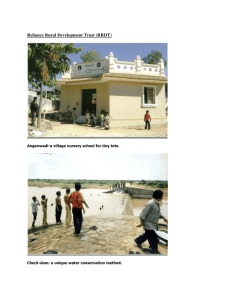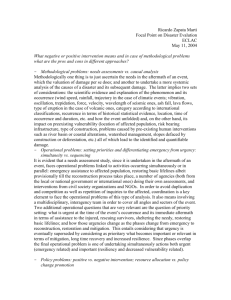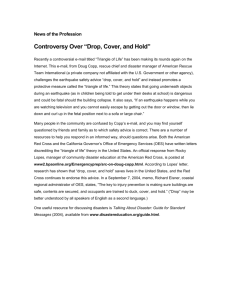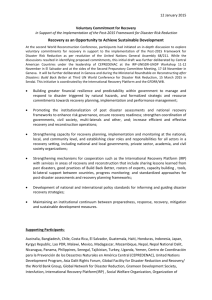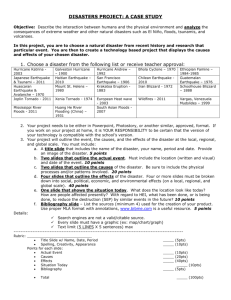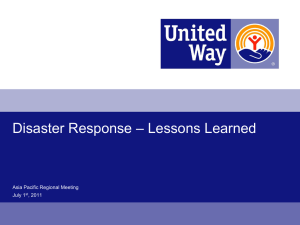GUJARAT EARTHQUAKE 2001?
advertisement
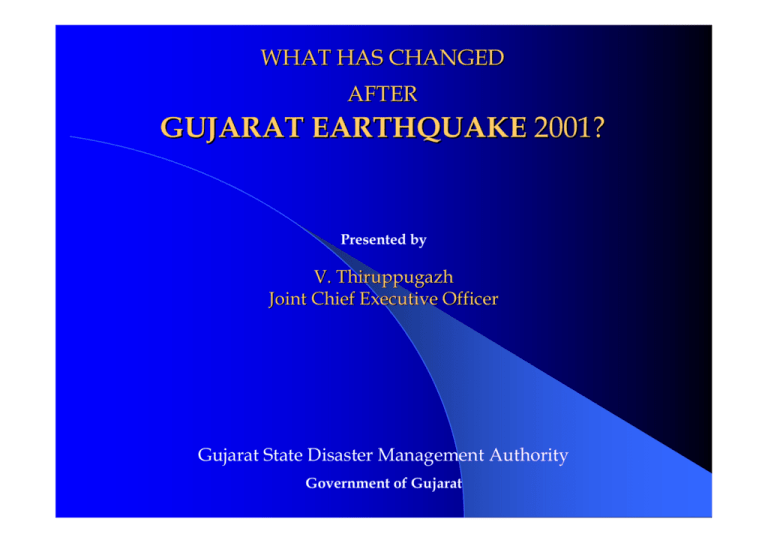
WHAT HAS CHANGED AFTER GUJARAT EARTHQUAKE 2001? Presented by V. Thiruppugazh Joint Chief Executive Officer Gujarat State Disaster Management Authority Government of Gujarat HAVOC AND DEVASTATION 26 January 2001: The Terrible Human Tragedy Earthquake of magnitude 6.9 on Richter scale; 7.7 Mw (USGS) One of the worst earthquakes in the last 180 years Reported lives lost 13,805 167,000 persons suffered injury Over 10 million people affected by the calamity Over 10,000 small and medium industrial units went out of production 50,000 artisans lost their livelihood Over 300 hospitals destroyed Around 5 million people needed to be given immediate relief 7,633 villages adversely affected, 450 villages flattened totally ….that too in the wake of two consecutive years of drought. IMPACT: LARGER PICTURE ¾Direct losses ¾ Human lives ¾ Livestock, other animals ¾ Private property ¾Indirect losses ¾ Export/ import ¾ Municipal infrastructure ¾ Agricultural output ¾ Power/ telecommunications infrastructure ¾ Industry/ services output ¾ Health/ education assets ¾ Fall in earning potential (due to disability, trauma etc.) ¾ Remittance income ¾ Unemployment ¾Gujarat earthquake estimate: US$ 2097 Million ¾ Health hazards ¾Gujarat earthquake estimate: US$ 635 Million ¾Tertiary losses ¾ Long-term development ¾ Overall investment climate ¾ Funds reallocation ¾ Community migration/ relocation ¾Gujarat earthquake estimate: US$ 3189 Million APPROACH TO RECONSTRUCTION AND REHABILITATION….. PROJECT SCOPE & OBJECTIVES ¾ Promoting sustainable recovery in the disaster- affected areas, and ¾ Laying the foundation for sustainable disaster management capacity in Gujarat. PROJECT OUTCOME ¾ Sustainable rehabilitation and reconstruction ¾ Reduced vulnerability and subsequent saving of lives and property in future disasters through building houses and infrastructure to hazard-resistant standards; ¾ Increased community risk awareness and preparedness for natural hazards through access to enhanced knowledge of hazards and disaster reduction techniques; and ¾ Enhanced emergency preparedness and response capacity of responsible units (such as fire & rescue brigades) leading to safety of lives and property. RECONSTRUCTION & REHABILITATION To co-ordinate the massive effort, a nodal agency was created – Gujarat State Disaster Management Authority Reconstruction Planning and Program Management Mitigation Planning, Monitoring, Implementing Emergency response Guidance & Monitoring … which effectively co-ordinates with all the entities associated with disaster management RECONSTRUCTION & REHABILITATION The reconstruction program has been designed to address the needs of beneficiaries comprehensively... REHABILITATION POLICY Short and Medium term Rehabilitation Policy... 28 Reconstruction and Rehabilitation packages Housing) Rehabilitation of orphans and women Packages for rural artisans Packages for capacity building Packages for industry, trade and services Packages for handicraft artisans Packages for agriculture Package for tourism Supported by Revival of Livelihood and Economy Trade and Enterprise Resurgence Renewal of Social Capital Reinforcement of Critical Infrastructure TOTAL ESTIMATED RECONSTRUCTION COST 642 80 335 36 339 25 144 Total Cost Rs. 7936 Cr. 2496 307 533 591 1034 Housing Education Rural Water Supply Urban Infrastructure Transportation Disaster Management Rural & Cottage Industry Others 246 743 385 Health Dams & Irrigation Public Buildings Power Agriculture Community Participation Project Management TASK AHEAD ¾ Repair of 9,17,158 houses ¾ Repair of 9,001 public buildings ¾ Repair of 42,678 school rooms ¾ Reconstruction of 2,22,035 houses ¾ Reconstruction of 3,377 public buildings ¾ Reconstruction of 12,750 school rooms ¾ Strengthening of 8,903 km of transmission and distribution lines ¾ Repair/Reconstruction of 4,973 km of state highways and rural roads ¾ Laying of 3975 km of water supply pipelines ¾ Livelihood restoration of 200,000 families and much more What has changed? Task Accomplished ¾ Over 9,08,710(99%) houses repaired and 1,97,091 houses (89%)houses reconstructed ¾ 42,678 schoolrooms repaired (100%) ¾ 12,442 Schoolrooms reconstructed ¾ 3,391 public building repaired ¾ 1,245 public buildings reconstructed and work in 562 buildings in progress ¾ 5,223 km of transmission and distribution lines has been strengthened ¾ Repair/reconstruction of 640 km of state highways & 3,061 km of rural roads completed ¾ Laying of 2,750 km of water supply pipelines including drilling of 222 deep tube wells ¾ Restored the livelihood of 2,00,000 families What has changed? Benefit Monitoring study Benefit Monitoring Consultant has been appointed with the objective ¾ To develop a benefit monitoring framework to record changes and developments taking place as a result of GEERP interventions ¾ Provide a real time feedback on project implementation and effect mid-course correction where possible Benefit to be monitored across 16 sectors ¾ Housing, agriculture, health, education, women’s livelihood, urban infrastructure, cottage and rural industries, roads and bridges, social rehabilitation, dams and irrigation, rural water supply, public buildings, power, industries and tourism, community participation, capacity building What has changed? Benefit Monitoring findings Sample Size: 4000 Villages: 65 Indicator Urban Locations : 14 Before the Earthquake After the Earthquake * Number of Pucca houses 66% 100% * Beneficiaries living in homes with separate toilets 32% 53% * Insurance of reconstructed houses 6% 49% * People knowing what to do before, during and after a disaster 0% 80% * Employment level among women 42% 92% * Water supply through pipelines at home 30% 34% * Quality of life index 1.00% 1.143% What has changed? Benefit Monitoring findings ¾ 39% beneficiaries in the four towns (Bhuj, Bhacau, Anjar and Rapar) are living in larger houses today as compared to 15% in other towns ¾ The proportion of beneficiaries surveyed receiving sweet water has increased by 10% in Kutch District. ¾ All G5 beneficiaries surveyed live in pucca houses ¾ 23% more BPL families live in pucca houses as compared to 14% more APL families ¾ More than 90% students who dropped out in both primary and secondary schools have rejoined ¾ 72% women surveyed have more income now compared to pre-earthquake levels DISASTER MANAGEMENT-A PARADIGM SHIFT ¾ The Gujarat earthquake resulted in a paradigm shift in the policy from relief and humanitarian assistance oriented post-disaster intervention to a pro-active prevention, mitigation and predisaster preparedness ¾ The Gujarat State Disaster Management Authority(GSDMA) was created on 8th February 2001 to act as a nodal agency for earthquake reconstruction after Gujarat Earthquake, 2001 ¾ Comprehensive Gujarat State Disaster Management Policy(GSDMP) was declared in November, 2002 ¾ For legal and regulatory requirement Gujarat State Disaster Management Act was enacted in March, 2003 GSDMA POLICY ¾ The policy resulted in a shift of focus from relief oriented approach to proactive disaster mitigation and risk reduction ¾ The policy identified hazard mitigation, vulnerability reduction, capacity building, integration of development planning with disaster management and emergency preparedness as the key activities to be undertaken as part of the long term strategy ¾ Defined roles and responsibilities of all stakeholders in various phases of disaster management GSDMA ACT ¾ Enacted in the year 2003 by Gujarat Assembly ¾ GSDMA act provides a legal and regulatory framework for disaster management in the state ¾ Act spells out clearly the duties of the various departments of the government of Gujarat, GSDMA, local self governments and community in pre and post earthquake disaster phases ¾ declaration of disasters, and provision of enhanced powers for the district and state government for effective rescue and relief in the aftermath of a disaster ¾ State Relief Commissioner and District Collectors have been empowered for emergency response ¾ Integrating development with disasters Housing an effort in DM and Capacity Building ¾ More than 1,80,000 houses constructed through owner driven reconstruction ¾ Government extended financial, technical and material help ¾ All newly reconstructed houses are Multi-Hazard resistant ¾ Owner driven reconstruction in Gujarat is one of the largest capacity building program for communities ¾ ¾ ¾ All newly reconstructed houses insured against 14 types of perils including earthquake 29,679 masons and master masons trained to construct houses that are earthquake resistant 6,500 engineers trained in earthquake engineering and seismic design codes WHAT GSDMA HAS DONE ¾ Formulation of Policies ¾ Preparation of DM Plans ¾ Preparedness Initiatives ¾ Capacity Building ¾ Mitigation Measures ¾ Community Preparedness DISASTER MANAGEMENT PLANS ¾ District level Multi Hazard DM Plan prepared for all 25 districts in Gujarat State ¾ Prepared state level response plan for chemical ,nuclear hazards, cyclone and flood ¾ Guidelines for cyclone contingency plan prepared and sent to districts ¾ State level earthquake management plan prepared ¾ On site/offsite plan for chemical disasters in all districts of the state prepared PREPAREDNESS ¾ Three teams of total 49 people from Fire brigade, Medicine and Traffic police successfully completed trainings at Netherlands and Germany ¾ The trained persons have in turn trained 190 first responders in the state. ¾ Training in fire rescue for 130 employees of public sector units ¾ 445 firemen/fire officers/home guards/police trained in Flood Rescue ¾ Familiarization municipalities training of 330 firemen/employees from 100 ¾ One Disaster Response Unit has been set-up under Ahmedabad Fire Brigade, with the help of Netherlands based NGO, CORDAID ¾ Emergency equipments and van provided to municipal corporations. ¾ Search and rescue equipment to be provided to municipal corporations in the state ¾ Rescue kits such as life jackets, rings given to all districts prone to CAPACITY BUILDING ¾ Revised syllabus of all Engineering colleges to include seismic engineering. ¾ Training programs for the teachers of Engineering Colleges on the revised curricula ¾ Syllabus of school has being revised by experts to include the basics of DM ¾ Introduced a chapter on Disaster Management in the First Year of PTC syllabus ¾ Gujarat School Safety Initiative launched to train school communities in 150 schools of cities such as Ahmedabad, Jamnagar and Vadodara ¾ Massive program for training of teachers in all districts launched ¾ Training of Trainers in Disaster Risk Reduction Program launched to train 100 Trainers of trainers, 1,625 teachers and 7,500 students and also to prepare school based DMP in one model school selected from each district of the state CAPACITY BUILDING Cont.d ¾ Competency based certification of masons program has been launched for the first time in India and 62 masons have been certified by Gujarat Council for Vocational Training ¾ Draft bill for licensing of engineers has been prepared. ¾ Provincial fire services to be set up ¾ Gender sensitisation training program for disaster management launched to train government officials, elected representatives and community leaders MITIGATION MEASURES - GUIDELINES ¾ For all types of construction like masonry, RCC structures, compressed mud earthen wall structures etc. ¾ Guidelines for multi hazards resistant construction has been Provided ¾ Guidelines provided for using local materials in hazardresistant construction ¾ Guidelines specifically for low cost reconstruction and retrofitting ¾ General Development Control Regulation has been revised ¾ ‘Revision of Building Codes’ is being taken up as a separate study that will enquire into the suitability of the existing building codes w.r.t. specific requirement of the region of Gujarat STUDIES COMMISSIONED ¾Seismic Microzonation ¾Review Of Building Codes ¾Early Warning and Communication System ¾Hazard Risk and Vulnerability Assessment ¾Damage & Loss Assessment ¾Establishment of Emergency Response Centres ¾Review of GSDMA – Its institutional set up, arrangements and future INSTITUTIONAL MECHANISM ¾ Institute of Seismological Research (ISR) ¾ Gujarat Institute for Disaster Management ¾ 3 regional centres for Emergency Response planned in the cities of Ahmedabad, Surat & Rajkot of Gujarat ¾ 22 Observatories and 40 SMAs to be established upgraded ¾ A seismic pavilion named “Planet We Live In” at Gujarat Science City ¾ Revision of State Relief Manual GUJARAT EXPERIENCE-A MODEL ¾ DM Shifted to home Ministry in Government of India from Agriculture Ministry ¾ Based on Gujarat Experience, a National level disaster management authority on the lines of GSDMA is being worked out at the central government level ¾ The planning commission has recommended for utilizing 10% of the plan funds for pre-disaster mitigation and planning activities ¾ Draft bill on National Disaster Management has been prepared ¾ Gujarat Experience resulted in a major change in the way reconstruction programs are being done in India and the neighboring countries. GUJARAT EXPERIENCE-A MODEL Gujarat Earthquake Reconstruction Experience have been looked at as a role model for reconstruction by ¾ Earthquake reconstruction program in Bam, Iran ¾ Tsunami reconstruction programs in Srilanka and Indonesia ¾ Tsunami rehabilitation and reconstruction programs of India VISION Imagine a Gujarat where….. Disaster strikes; Risk assessment Information monitoring Communities react with sense of urgency but in a planned way Awareness Training Drills Contingency plans Only a few structures are damaged … with a limited death toll ... and a limited impact on the state exchequer Risk transfer mechanisms Planned development Contingency plans Policies, guidelines Rapid response Effective program mechanisms management INTERNATIONAL RECOGNITIONS ¾GSDMA was awarded the UN Sasakawa Award for Disaster Reduction for the year 2003 ¾GSDMA awarded CAPAM award for Innovations in Governance ¾GEERP awarded Green Award by World Bank for successfully integrating environmental concerns in the emergency reconstruction program.

